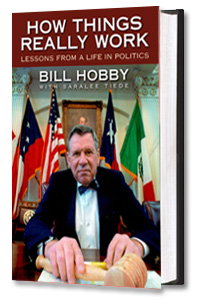The Hobbys and the Johnsons have been friends for three generations now, bound together by broadcasting and government.
Mrs. Johnson was the broadcaster in the family.
Luci Baines Johnson grew up in both businesses, as did I.
Sam Ealy Johnson, President Johnson’s father, and I.W. Culp, my grandfather, served together in the Texas House of Representatives.
Mrs. Johnson began her broadcasting career as the owner of a radio station in Austin then bought a television station. Of course the call letters of both stations were and are KLBJ. Mrs. Johnson later bought stations in other Texas cities.
Being married to a public official is no easy task for a woman. Mrs. Johnson was the only such wife and mother I ever knew that enjoyed it. Lynda Johnson Robb and Luci Baines Johnson are the showcases what a great job she did.
Wildflowers were, of course, Mrs. Johnson’s passion. She started a program to beautify Texas highways by sponsoring a contest among Highway Department district engineers to see who had could most beautify their highways.
She founded the Lady Bird Johnson Wildflower Center outside of Austin.
The Lady Bird Johnson Wildflower Center is working on several projects that use native plants to combat climate change.
Global warming is caused by carbon dioxide. Plants inhale carbon dioxide and exhale oxygen. In urban areas, well-planned landscapes can not only pull CO2 from the air, but store it in the soil for decades.
One Wildflower Center product, done in cooperation with the Seattle-based environmental company, Mithun, is an open-user, web-based carbon calculator which can aid developers in calculating the total carbon footprint of their projects.
It’s one more tool to deal with perhaps the greatest challenge now facing the earth. It goes hand in hand with the Wildflower Center’s work on green roofs, which reduce energy demand in the buildings beneath them, and standards for sustainable landscapes.
The Center preserves seeds of species of flowers that would otherwise become extinct. That environmental research will continue because, a year before Mrs. Johnson died, the Center became a part of the College of Natural Sciences at University of Texas at Austin.
President Johnson is memorialized by the Lyndon B. Johnson Museum, Library, and School of Public Affairs (where I used to teach).
LBJ left his letters and tapes to the library with a stipulation that they not be released until 35 years after his death—next year. Several years ago, Mrs. Johnson decided to start releasing them as soon as possible.
The archiving process is long and tedious. Under federal law the archivists must have security clearances. There is still concern about releasing information that may have been acquired by breaking other nations’ codes and compromising our country’s ability to get that kind of intelligence.
Perhaps twenty percent of the information has now been published electronically or in print, beginning with the material relating to the Kennedy assassination.
We are farther down that road than we would have been but for Mrs. Johnson’s concern about the openness and availability of public documents, tapes, and videos.
In contrast, President George W. Bush loves secrecy and has made information in more recent Presidential libraries harder to get.
Mrs. Johnson finished the course and kept the faith. Well done, thou good and faithful servant.
We shall not see her like again.

